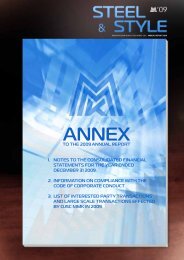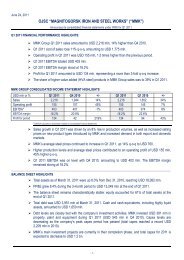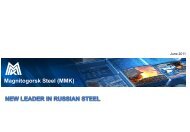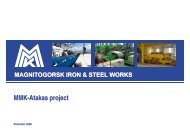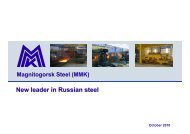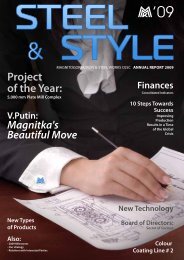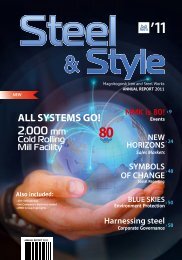Annual report 2007 - Magnitogorsk Iron & Steel Works ...
Annual report 2007 - Magnitogorsk Iron & Steel Works ...
Annual report 2007 - Magnitogorsk Iron & Steel Works ...
Create successful ePaper yourself
Turn your PDF publications into a flip-book with our unique Google optimized e-Paper software.
2<br />
Greeting of the President of Russia Vladimir Putin on the<br />
occasion of the 7 th Anniversary of MMK:<br />
“Built within a record time, the legendary Magnitka became not<br />
only the most important industrial enterprise in the area, but also a<br />
symbol of the country’s industrialization and its power. I am confident<br />
that you will continue to make significant contributions to the<br />
strengthening of the national economy”.<br />
18.07.07<br />
History<br />
The <strong>Magnitogorsk</strong> <strong>Iron</strong> and <strong>Steel</strong> <strong>Works</strong> sprang up on the left bank of the Ural River in the first half of the<br />
last century, next to a unique deposit of iron ore of Mountain Magnitnaya (“Magnetic Mountain).. This relatively<br />
small tract of land contained almost half a billion tonnes of high grade iron ore.<br />
That there is magnetic ore in the place was known as far back as the XVIII century. In 1743, not far from<br />
Mountain Magnitnaya, the governor of Orenburg founded a fort of the same name (“Stanitsa Magnitnaya”).<br />
In the late XIX century a Russian government committee lead by D.Mendeleyev, a world-renowned scientist,<br />
explored the Urals Mountains and highly praised the quantity and quality of the ore in Mountain Magnitnaya.<br />
The design of the <strong>Magnitogorsk</strong> <strong>Works</strong> started in May of 1925. Construction began in 1929 and was<br />
completed within a record time. In spite of extremely hard conditions in which builders of Magnitka had to<br />
work, on February the 1st of 1932 Blast Furnace # 1 produced first pig iron, with Blast Furnace # 2 following suit<br />
in the summer of the same year.<br />
1933 saw the start-up of Blast Furnaces ## 3 and 4, and four open-hearth furnaces, thus marking the start of<br />
steel smelting at the <strong>Works</strong>.<br />
In August 1934, the first section mill (500 mm) was brought on line. The mill turned the <strong>Works</strong> into a large<br />
supplier of long products and a fully integrated steel mill. In the period from 1935 to 1938 the <strong>Works</strong> put 5 more<br />
long products mills into operation. Before the Second World War the <strong>Works</strong> processed about 25% of all iron ore<br />
mined in the USSR, produced 12% of pig iron and 10% of steel sheets.<br />
Soon after the start of the war, the <strong>Works</strong> received an order for armour steel, and within a month such steel<br />
was smelted. Thanks to an innovative solution, for the first time in the history of world steel making, armour<br />
plate was rolled on a blooming mill. Another pioneering move was to smelt armour steel in a large-capacity<br />
open hearth furnace. With the commissioning of the USSR’s most powerful 4,500 mm armour plate mill MMK’s<br />
production of armour plate was significantly increased. In 1942–1943 the world’s largest Blast Furnaces ## 5 and<br />
6 were started up at the <strong>Works</strong>. In the years of WWII every third shell and every second tank’s armour was made<br />
from <strong>Magnitogorsk</strong> steel.<br />
After the war MMK remained “the flagship” of the Soviet steel industry.<br />
In 1966 the <strong>Works</strong> was operating 10 blast furnaces, 10 open-hearth furnaces and 15 rolling mills.<br />
In 1989 MMK reached its highest ever level of steel production of 16 million tonnes.<br />
In 1990 a new BOF (converter) steel making division was commissioned at MMK. .<br />
In 1992, in accordance with the state privatization program, the <strong>Magnitogorsk</strong> <strong>Works</strong> was converted into an<br />
open joint stock company (OJSC MMK). The key goal at this stage was to continue revamping and modernizing<br />
the main production assets. In 1994 a 2,000 mm hot rolling mill with a capacity of 5 million tpy was brought on<br />
stream. 1999 saw the commissioning of the third BOF Converter and of the coke gas treatment plant. The blast<br />
furnace and sinter divisions were significantly upgraded. In 2002 two first-of-its-kind facilities were started up<br />
at MMK: a 1,700 mm two-stand reversing cold mill with a capacity of 800,000 tpy of cold rolled strip, and the<br />
country’s largest hot dip galvanizing line with a capacity of 500,000 tpy. This was followed in 2004 by a 200,000<br />
tpy colour coating line.





